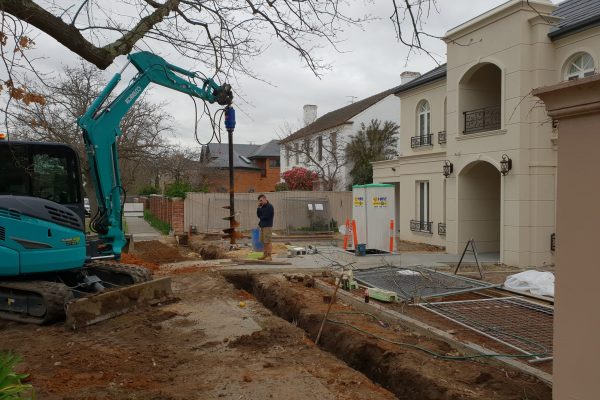Drainage systems are important for helping your retaining walls perform as expected while making them last longer. When water seeps into the soil behind a wall, the pressure pushes against the structure, causing stress that can exceed the wall’s design capacity.
Even well-built walls are vulnerable if you don’t manage drainage, so let’s discuss the effects of poor drainage, the benefits of a good drainage system, and the best drainage system solutions.
Effects of Poor Drainage on Retaining Walls
Structural Failure
When water builds up behind a retaining wall, the pressure pushes directly against the structure. Over time, this extra load can cause tilting, bulging, or even total collapse if not addressed quickly.
Soil Erosion
Standing water saturates the soil and gradually washes it away. As the soil base weakens, the wall loses its foundation support, which accelerates cracking mortar, bulging areas, or a slight forward lean.
Recurring Maintenance
Homeowners often notice cracks that keep reappearing even after patching. This happens because poor drainage keeps undermining the wall, making repairs temporary rather than permanent.
Safety Risks
A retaining wall that fails poses more than just cosmetic issues. In sloped yards or near driveways, a collapse can damage property or create hazards for people using the space.
How Good Drainage Increases Lifespan
Proper drainage systems significantly reduce stress on your retaining walls by redirecting water before it builds up. By lowering hydrostatic pressure, drainage systems allow walls to hold back soil without extra load.
Effective systems also protect the soil structure itself, keeping it compact and preventing erosion that undermines the wall’s base. In colder conditions, drainage reduces freeze-thaw cycles that cause cracks and gradual displacement. A wall with well-designed drainage maintains its alignment and strength for decades, extending its service life far beyond one that was built without these considerations.

Best Drainage Solution For Retaining Walls
1
Gravel Backfill
A gravel layer behind the wall allows water to pass through freely, preventing soil from becoming saturated. This is one of the simplest and most effective ways to reduce water pressure, and is commonly used in retaining walls across Melbourne.
2
Drainage Pipes and Weep Holes
Installing perforated pipes or leaving gaps for weep holes ensures trapped water has an escape route. These systems are especially important in walls that hold large amounts of soil, like taller retaining walls for steeper slopes.
3
Geotextile Fabric
By working as a filter, geotextile fabric lets water through while keeping soil particles out of the drainage system. This prevents clogs that can render the system ineffective.
4
Surface Grading
How your retaining walls perform also depends on where the surface water flows, not just the amount of soil behind them. Grading the land so water drains away from the wall reduces the burden on the internal drainage system.
Maintenance Tips For Better Drainage
Check for Blockages
Check your weep holes and pipes for obstructions caused by soil, leaves, or root growth. Even small blockages in these pipes can quickly reduce drainage capacity, putting extra load on your walls.
Inspect After Heavy Rain
The monsoon season usually reveals problems that aren’t obvious in dry weather. After a storm, check the area around your walls for pooling water, cracks forming in the wall, or soil that appears to be sinking.
Replenish the Gravel Backfill
Over time, gravel can settle or compact, reducing its ability to channel water away from your retaining walls. Adding fresh gravel allows water to move freely behind the wall.
Maintain Surface Grading
If the ground has shifted (which can happen over time), water may start flowing toward the wall instead of away from it. Adjusting the slope will ensure that water flows away from the wall, preventing unnecessary water pressure.
Call Professionals When You See Damage
Small cracks, slight leaning, or damp patches may seem minor but often signal drainage failure. Addressing these issues early by calling a professional like Jamesco Group can prevent costly rebuilds later.
Professional Retaining Walls in Melbourne with Quality Drainage Systems
Your retaining walls need an effective drainage system to function properly and last longer without major repairs. Poor drainage can cause soil erosion, structural failure, and safety risks. The best drainage solutions include gravel backfill, drainage pipes, geotextile fabric, and proper surface grading, but they require maintenance like replenishing gravel backfill and checking pipes for blockages.
To set up retaining walls in Melbourne with effective drainage systems, it’s best to call a professional. At Jamesco Group, we specialise in building custom retaining walls that meet your needs
